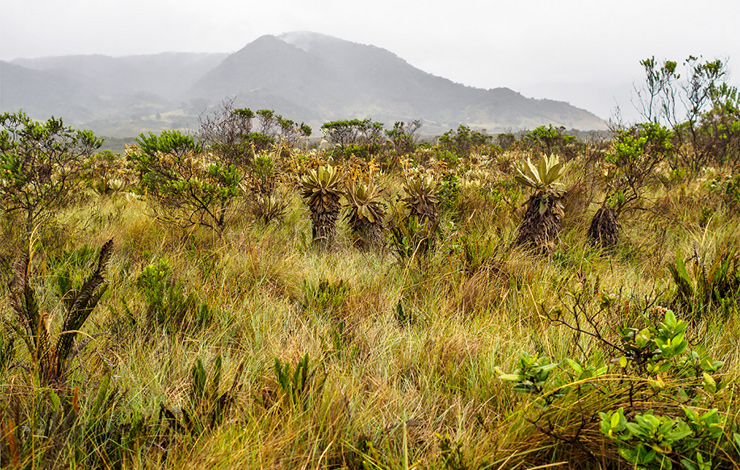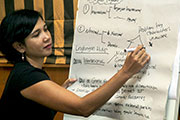This program seeks to address the violations of the Rule of Law for Colombia’s campesino population's exposure to the aerial fumigation of the coca plant, violating their territorial sovereignty.
Challenge

Colombia is one of the lowest ranking countries in the "Order and Security" section of the World Justice Project's Rule of Law Index, the result of an internal conflict that has affected the country for decades, manifesting itself in extreme violence against the country’s population, and in particular, its rural population. This program seeks to address the violations of the Rule of Law for Colombia’s campesino population's exposure to the aerial fumigation of the coca plant, violating their territorial sovereignty. The focus on Colombia’s indigenous campesino population is important as this part of society has been subject to extreme discrimination within the civil justice system. In addition to a continual denial of their constitutional right to territorial sovereignty, they suffer from a stream of abuses and violations to their fundamental rights (WJP Subfactor 4.2: a Right to Life and Security). Due to the deeply engrained racism in Colombian society, civil justice has never been effectively enforced.
In 1999, with the onset of Plan Colombia, aerial fumigation became one of the main weapons in Colombia’s War on Drugs. The violations referred to above, engendered by the act of aerial fumigation, are two-fold: they affect both the natural environment and the population whose survival depends on the survival of the earth. In addition, it is important to note that the harvesting and growing of coca is a culturally sacred activity to many indigenous peoples living in Colombia. Moreover, the eradication of this plant is an eradication of a means of living, a way of life, a method of organization, both social and economic. These factors, along with the detrimental physical effects that the herbicide glyphosate has on the human body, bind human rights law to the environment in a way that has been previously unrecognized in Colombian and international law. Within the struggle to gain self-determination, territorial sovereignty, and equal treatment under the eyes of the law, lies a deep connection to the right to cultivate land. The decline of traditional small farming has been synonymous with the decline of personal freedom, capital expansion, and the suspension of law. As a result the act of farming has become an important assertion of a constitutional right to territory for Indigenous communities.
Program Summary
This project is a series of workshops combining artistic practice, farming, and legal studies. These workshops are part of the Pedagogy of Mother Earth program at the University of Antioquia and took place over the course of one academic year from early August 2013 to May 2014. The success of this project lies in a unique collaboration between the university, the residency, and an ongoing research project. Before implementing the workshops, the program leader worked with the Regional Indigenous Council of Cauca (CRIC) to document the ways in which aerial fumigation affected traditional small farming practices in northern Cauca. The fieldwork informed the workshops. The workshops focus on the development of environmental international law in relation to social and natural injustices, permaculture and social struggles within Colombia, and how the production of visual material can be integrated into a research practice. These classes serve as a connection between the university, the Mother Earth course, and the residency, bringing the students of the course to the surrounding community in Medellín, as normally the majority of their classes take place within their own rural communities. At the end of the year those taking part in the residency will produce a visualization to be displayed within different cultural institutions in Medellín. This visualization will be in the form of photography, film, and audio recordings. The final product is a book, which will include writing, diagrams, photographs and maps, all outlining the possibilities of interaction between the earth, indigenous rights, and environmental law.
Impact
Participating students benefit from the workshops. In working with the students in a dynamic, practice-based manner, these workshops will provide vital knowledge for future generations to seek justice and reparations for past violations of their territorial sovereignty and right to security, as they are protected under the Colombian constitution and through the 1989 Tribal and Indigenous People’s conference, which Colombia ratified in 1992. In the long term, the project has advocacy-oriented goals as well as educational ones.
The aim of this collaborative research is to demonstrate, using a legal framework, how glyphosate, mixed with other chemicals known as surfactants, which are deployed during aerial fumigation, act as a “surface weapon”. This means that the chemical is capable of attacking a multiplicity of surfaces, without the ability to discern between illegal or legal plant life, or human life, and national borders. Once released from an aircraft, the toxin is subject to meteorological factors, air currents, ground water movement, tributaries etc., thus complicating the process of gathering evidence to prove the connections between incidences of environmental destruction and human illness, and the actual fumigations. Materials produced in the workshops and other research serve as advocacy tools to raise awareness of human and environmental rights, which will help those affected by aerial fumigation in the long run through greater access to the civil justice system.
Anticipated Issues
This project situates itself between a conflict of so-called “minor” and “major” sciences. This conflict, which is bound in racism and different modes of knowledge production, is at the heart of the significance of the Pedagogy of Mother Earth course. This is not to say that this program, or our project have overcome the legacy of colonialism. Indigenous knowledge often comes into conflict with modern science and governing structures. It is crucial to develop ways in which different knowledges, traditions, and sciences can work together in order to build a sustainable and secure life. The obstacles that myself and Mr. Monzón encountered this past summer while working in Cauca with CRIC, the Regional Indigenous Council of Cauca, was more than just a language barrier. We witnessed tense negotiations between governmental ministers and tribal leaders, where simple dialogue itself was a challenge. Within the context of a university it is especially important to bridge these gaps and the challenge will be to make these differences productive and not just a barrier to meaningful communication. In addition, I appreciate that due to the volatile nature of Colombia’s armed conflict, my own research will have to remain flexible as to where and when the actual fieldwork can be conducted. This will not be a problem as aerial fumigation is common throughout the country and my partners and contacts will keep me up-to-date with the security in a particular area.
Partners
Partners include both Andrés Monzón the director of Campos de Gutiérrez, and Abadío Green, the director of the Pedagogy of Mother Earth program at the University of Antioquia (http://www.pedagogiamadretierra.org/). The Campos foundation hosts artists and academics for short residencies. Their website is http://www.camposdegutierrez.org/.

